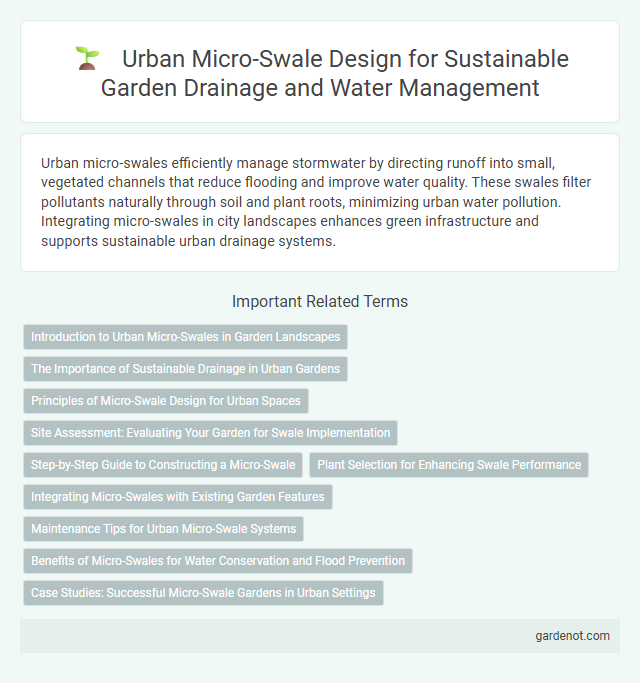Urban micro-swales efficiently manage stormwater by directing runoff into small, vegetated channels that reduce flooding and improve water quality. These swales filter pollutants naturally through soil and plant roots, minimizing urban water pollution. Integrating micro-swales in city landscapes enhances green infrastructure and supports sustainable urban drainage systems.
Introduction to Urban Micro-Swales in Garden Landscapes
Urban micro-swales are shallow, vegetated channels designed to capture and infiltrate stormwater runoff in garden landscapes, reducing soil erosion and improving water quality. These sustainable drainage features mimic natural water flow patterns, promoting groundwater recharge and supporting native plant growth. Integrating micro-swales into urban gardens enhances landscape aesthetics while mitigating flooding risks and managing urban runoff efficiently.
The Importance of Sustainable Drainage in Urban Gardens
Urban micro-swales are essential for sustainable drainage in city gardens, effectively managing stormwater runoff by promoting infiltration and reducing flood risks. These shallow, vegetated channels capture rainwater, filter pollutants, and support groundwater recharge, enhancing urban biodiversity and soil health. Implementing micro-swales in urban landscaping aligns with green infrastructure practices that mitigate urban heat islands and improve overall environmental resilience.
Principles of Micro-Swale Design for Urban Spaces
Urban micro-swales optimize stormwater management by slowing runoff, promoting infiltration, and filtering pollutants through strategically designed shallow channels lined with vegetation. Key principles include sizing the swale to accommodate specific rainfall events, using native plants to enhance pollutant uptake and bank stabilization, and ensuring proper soil composition for effective water absorption. Effective design integrates micro-swales within urban landscapes to mitigate flooding, recharge groundwater, and improve water quality.
Site Assessment: Evaluating Your Garden for Swale Implementation
Urban micro-swale site assessment involves analyzing soil permeability, slope gradient, and existing drainage patterns to ensure effective water capture and infiltration. Identifying areas with compacted soil or poor drainage helps determine optimal swale placement to prevent runoff and erosion. Incorporating native vegetation in the swale design enhances sediment filtration and promotes groundwater recharge in urban garden settings.
Step-by-Step Guide to Constructing a Micro-Swale
Constructing an urban micro-swale begins with selecting a low-lying area where water naturally accumulates, ensuring proper site assessment for soil permeability and slope gradient. Excavate a shallow, elongated trench following the contour lines, typically 6 to 12 inches deep and 1 to 3 feet wide, to promote efficient stormwater capture and infiltration. Finish by lining the swale with native vegetation such as grasses or sedges to stabilize soil, enhance filtration, and support urban biodiversity.
Plant Selection for Enhancing Swale Performance
Selecting native, drought-tolerant plants with deep root systems enhances urban micro-swale performance by improving soil infiltration and reducing runoff. Species such as Carex, Juncus, and Muhlenbergia effectively stabilize soil, filter pollutants, and support local biodiversity. Proper plant diversity increases water retention capacity and resilience against urban stressors.
Integrating Micro-Swales with Existing Garden Features
Urban micro-swales enhance stormwater management by seamlessly integrating with existing garden features such as rain gardens, permeable pavements, and native plant beds. This integration maximizes water infiltration, reduces runoff, and supports urban biodiversity by creating functional green corridors. Properly designed micro-swales complement landscape aesthetics while improving water quality and mitigating urban flooding risks.
Maintenance Tips for Urban Micro-Swale Systems
Regular inspection and removal of debris in urban micro-swale systems prevent blockages and maintain optimal stormwater flow. Vegetation management, including periodic trimming and replanting with native species, enhances filtration and prevents erosion. Monitoring soil infiltration rates and addressing compaction ensures the swale's effectiveness in reducing runoff and improving water quality.
Benefits of Micro-Swales for Water Conservation and Flood Prevention
Urban micro-swales enhance water conservation by capturing and infiltrating stormwater runoff, reducing surface water loss and replenishing groundwater supplies. These shallow, vegetated channels mitigate flood risks by slowing down runoff, preventing erosion, and decreasing peak flow volumes during heavy rain events. Their integration into urban landscapes promotes sustainable water management and improves overall ecosystem resilience.
Case Studies: Successful Micro-Swale Gardens in Urban Settings
Urban micro-swale gardens effectively manage stormwater by capturing and slowly filtering runoff, reducing urban flooding and improving groundwater recharge. Case studies in cities like Portland, Oregon, and Minneapolis, Minnesota demonstrate significant reductions in surface water pollution and enhanced green space aesthetics, fostering biodiversity in densely built environments. These projects showcase scalable, low-impact infrastructure that integrates native plantings, promoting sustainable urban water management and ecological resilience.
Urban micro-swale Infographic

 gardenot.com
gardenot.com